Subscribe now to get notified about IU Jharkhand journal updates!
Transactional Efficacy of Internet in Rural India
Abstract :
The Internet is developed as a source of information for enhancing knowledge for better productivity & increase efficiency. But over time, with developments in social media,internet is considered an effective medium for entertainment and social networking. Although internet penetration in rural India is also growing at a fast speed but the major use of the internet is only for social media for increasing communication. Transactional use like enhancing knowledge, business opportunity, and eCommerce it was very less. Therefore, this paper aims to identify the factors influencing the expected use of internet in rural India and the impact of demographic factors on Internet adoption and usage in rural areas. Finally the results of the study lead us to conclude that demographic factors like age, occupation is not the deciding factor for the use of internet but the income, education and digital literacy are the major reason for the effective use i.e for business or knowledge building activities on the internet.
Keywords :
Internet, Rural, demographics, social media, expected useIntroduction :
An article in Livemint, “Internet usage picks up in rural India” Bharat is getting online faster than India. By 2020, share of rural India will jump to 48%, creating a huge opportunity for brands and marketers in places where establishing a physical presence is still a challenge, Indian government has bought several policy initiatives, including the provision of subsidized Personal Computers and affordable internet connectivity to support Internet access in rural areas. Access to the internet over mobiles due to the availability of low cost smartphones, data package and increasing awareness of popular apps such as Whatsapp, Facebook etc.are growth drivers of rural users.
The internet is primarily considered as a source of information for knowledge enhancement, but with developments in social media and eCommerce, Internet is considered an effective medium for social networking and enhancing economic benefits. According to the report, Mobile Internet in India 2015, 52% of people said their primary reason for accessing the internet was entertainment followed by Communication and social networking at 37% and 39% respectively.
The Internet forms the basic tool of governance, especially in rural areas, where people’s access to institutions is limited, due to poor physical and institutional availability besides access to knowledge and economic opportunities. This gap leads to both inefficiencies in service provision and excluded from knowledge, economic opportunities and governance.
Major problem is the availability of infrastructure for access to the Internet. Low penetration of Internet in rural is also due to unaffordability of smart phone & computers, lower education profile and digital literacy in villages. Thus, it is important to study drivers of Internet use in rural India not only to plan the strategies, but also theoretical and empirical perspective for business and government. For this primary research is to understand factors influencing the expected use of the internet and the further, studies have indicated that age, occupation, income, education and gender are factors that could lead to differential use of the Internet.
Literature Review
According to the study by Boston consultancy group titled, “The rising connected consumer in Rural India” almost 70% of the rural Indian use internet to access social networks followed by the gaming media, emailing.
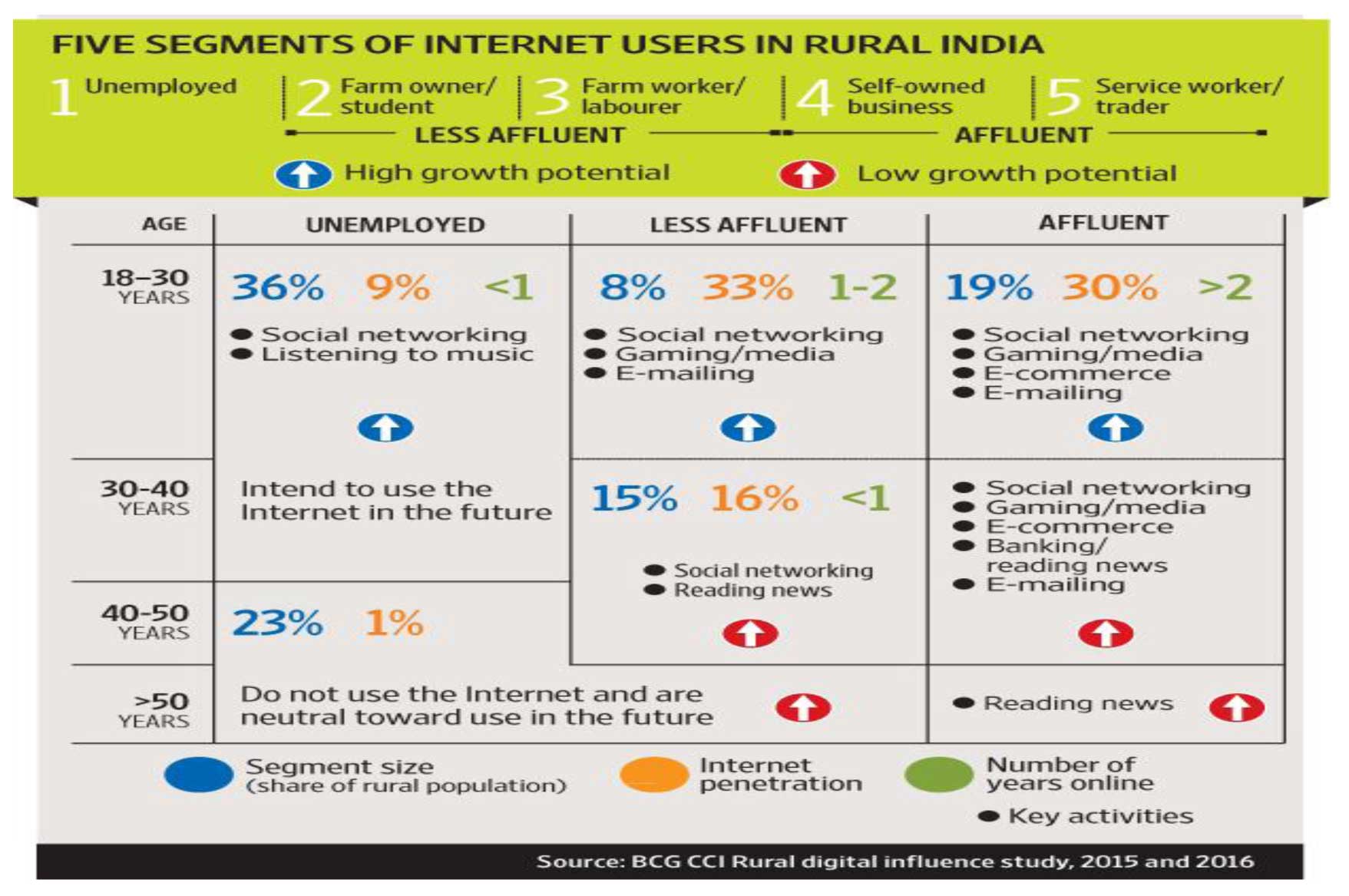
Electronic government (e-Government) is one of the most important ways to bridge the digital divide in developing countries.Viswanath Venkatesh1, Tracy Ann Sykes2 and Srinivasan Venkatraman3 ( 2013) conducted a field study in a village in India of e-Government portal use and observed that demographic variables and personality traits are being significant and explaining 40% of the variance in e-Government portal use.
Factors for adoption of Internet Usage
Prof Rekha Jain (October 1, 2016), ‘Factors Influencing Perceived Impact of Internet Use on Individuals in Rural India’ TPRC44, Research
Conference on Communications, Information and Internet Policy, Arlington, VA, examine internet adoption and usage in rural India from a
socioeconomic perspective while considering factors like social capital, economic and knowledge enhancement and exchange in assessing the
perceived impact
Dhyan Singh (Nov 2014, Volume-IV), Online International Interdisciplinary Research Journal, ‘A Systematic Review of Literature on effect of Internet
Use on Students in India’ study concludes that internet users still face many problems while surfing the internet in which low speed, downloading
problems, availability of reliable information, location and other handling problems are primary. It is also found that both faculty members and
students are not updated about their internet knowledge. VivekPai ,( November 18, 2015) in his Report titled, ‘25% of India’s population uses the
Internet: IAMAI-IMRB” compare the purpose of usage of internet in urban and rural area’ he has interviewed 5000 respondents of various age group.
71% of the urban respondents mentioned that they used the internet for communication, followed by 67% for social networking and 59% for entertainment. 24% of urban users used the internet to purchase products while 23% used it to book tickets.
In rural areas on the other hand, 44% of the users used the internet for entertainment, 37% of communication, 33% of social media, 14% for online
ticketing and 5% of online shopping, indicating that online shopping hasn’t yet really taken off in rural areas.
Digital Literacy
Government to launch Digital literacy mission for 60 million rural Indians IANS Jun 26, 2016, India will soon launch a Rs 1,800 crore ($265 million) Digital Literacy Mission for 60 million people in rural areas.
Research Problem
Various studies and reports shows that there is an increase in the usage of the internet in rural India. Studies in this area have focused on individuals and understanding what drives Internet use. As discussed primary use of the internet by the rural people is entertainment which is followed by communication and social media. The difference in the use of urban and rural is may be due to poor physical infrastructure. But in rural areas the need of internet connectivity for receiving social and market related information in the absence of proper roads and transportation may be greater. Reach for bigger market and understanding of market dynamism is more. But Internet penetration for this business and knowledge purpose is less. Internet adoption and usage may be very different in rural areas depending on the education and income profile. Therefore, it has become important to study the factors influencing Internet adoption and their usage in an increasing number of internet users and mobile Internet penetration in rural areas.
Objective of Research
Research Methods
The study is based on a survey in two rural areas of Vidharbha in Buldhana district. Intention of the survey is to understand the Internet
adoption and usage profile of rural India.
The questionnaire used with a Likert Scale is made to understand the usage of internet for social networking, business and knowledge related activities. The scale had five categories ranging from Strongly Disagree (1), Disagree (2), Neither Agree or Disagree (3), Agree (4) to Strongly Agree (5). The number of survey respondents was 100.
Internet users were asked to rate how the outcomes of Internet use helped them in developing their social relations, creating economic opportunities and exchanging knowledge.
Increase in efficiency of Work:
Use of Internet helps in increasing the number of customer, increase in reach of the wider geographical area, reducing costs by developing efficiency in transaction and also by reducing time for travel, searching information, less time for processing transactions, the increase in new and existing job opportunities etc.
Empowerment: Due to availability of current information on the Internet, developing a social network, getting help in an
emergency, and help in knowledge creation to understand different topic without the help of others.
Performing transactions related to banking, online shopping ANNOVA is used as a statistical tool for analysis
Sample size:100 samples collected from two districts of Vidharbha, (Akola ,Buldhana) Reliability test for the sample is attached in Appendix 2 and Descriptive analysis is in Appendix 1 for understanding the sample The profile of users in the survey is provided in Table 1
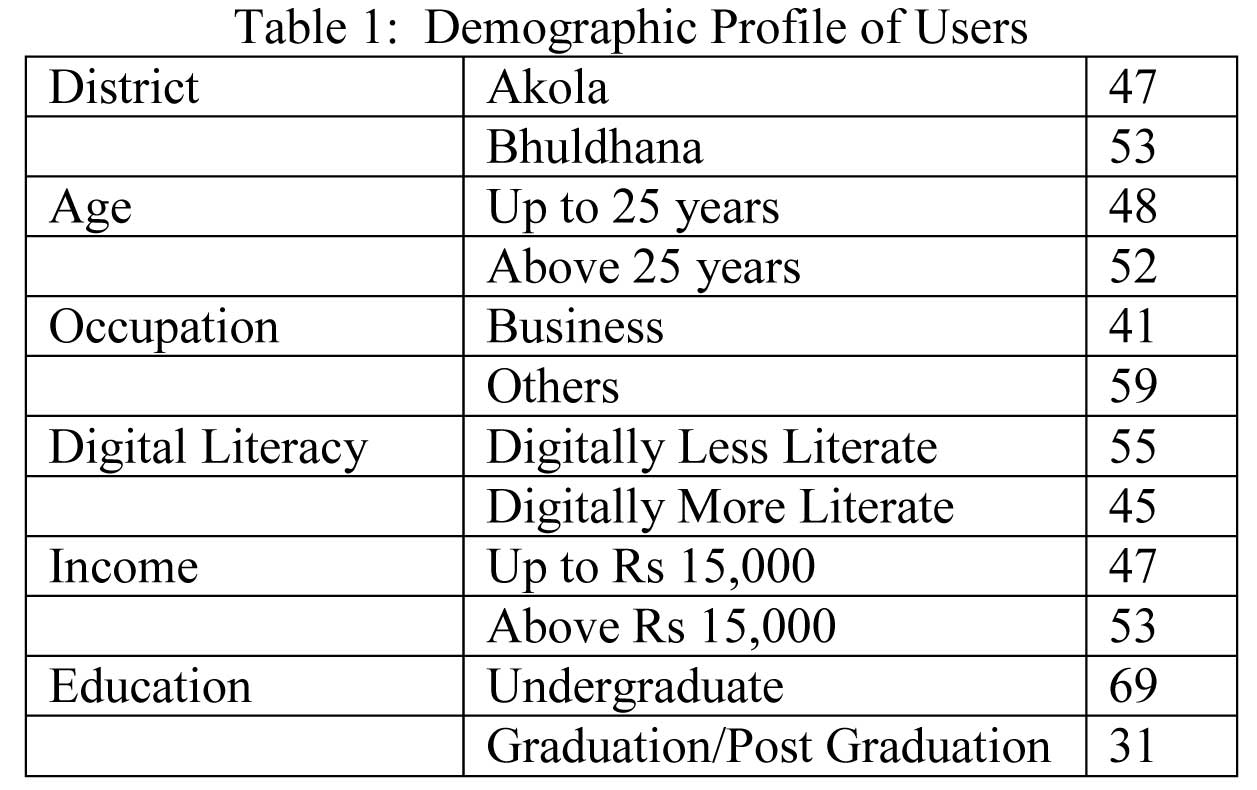
Findings
Impact of age on Expected Use of Internet:
Ho:-There is no significant difference between the different age groups and Efficiency of Work, Empowerment, Efficiency in Transaction
Ha1:-There is significant difference between the different age groups and Efficiency of Work, Empowerment, Efficiency in Transaction
Accoring to Table 2, One way ANOVA result for ‘Age’ up to 25 years and above 25 years on three components Increase in Efficiency of Work, Empowerment, Efficiency in Transaction at 5 % level of significance shows that no statistically significant differences in responses with respect to ‘Age’. Hence the null hypothesis is accepted.
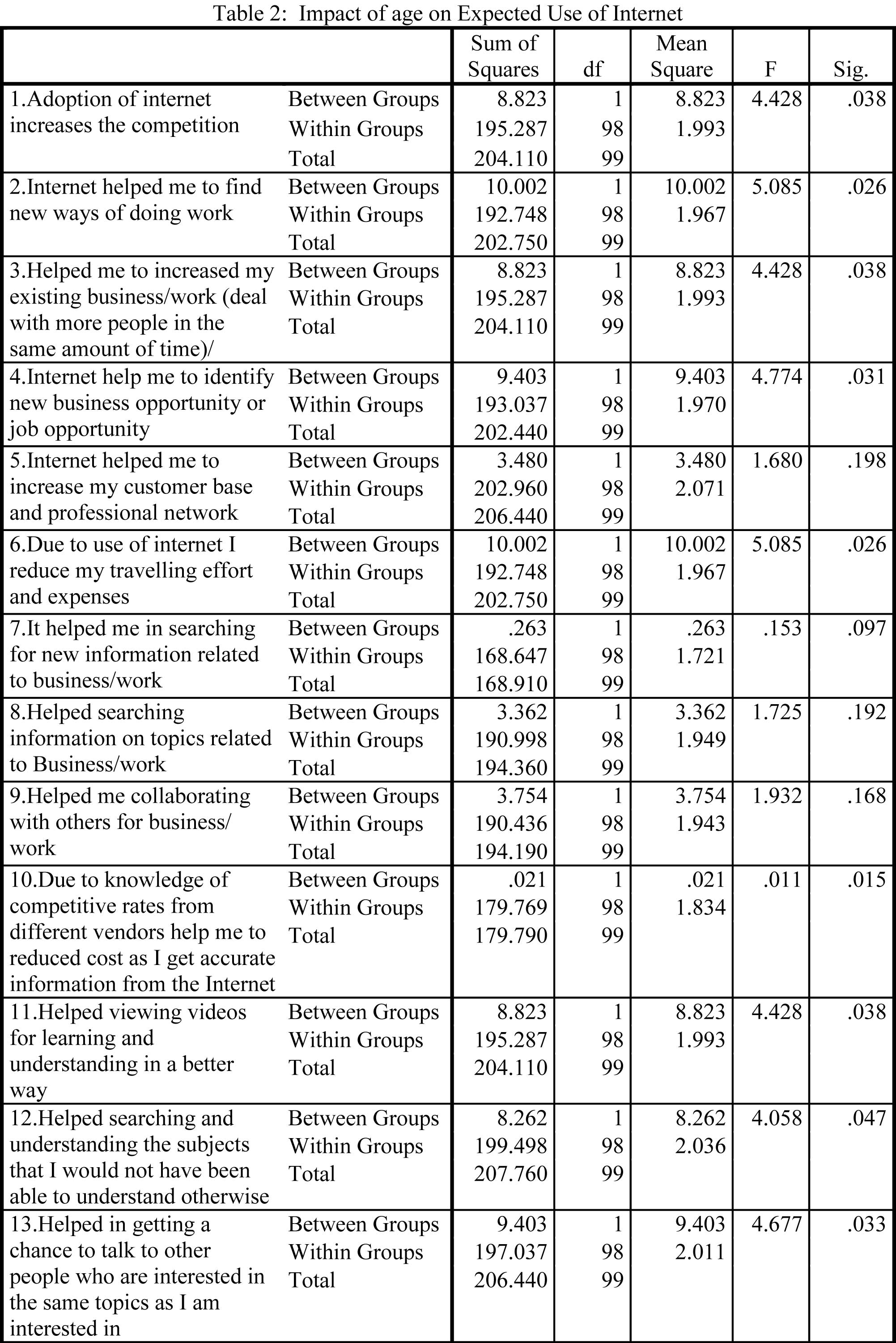
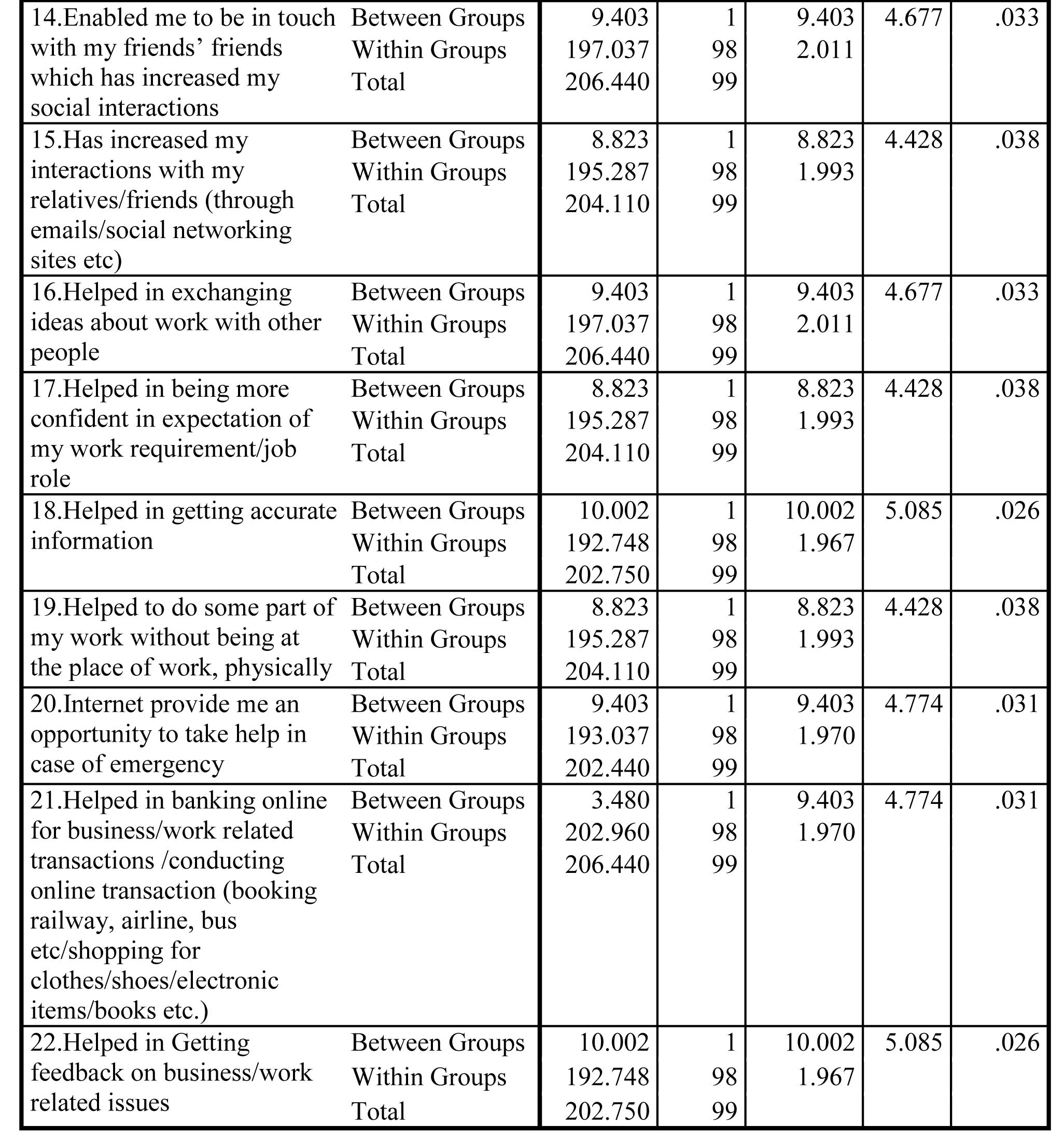
Impact of Occupation on Expected Use of Internet:
Ho2:-There is no significant difference between the occupation and Efficiency of Work, Empowerment, Efficiency in Transaction
Ha2:-There is a significant difference between the occupation and Efficiency of Work, Empowerment, Efficiency in Transaction
One way ANOVA result of occupation in Table 3, on three components Increase in Efficiency of Work, Empowerment, Efficiency in Transaction at 5 %
level of significance shows that there is no statistically significant differences in responses. Hence the null hypothesis is accepted.
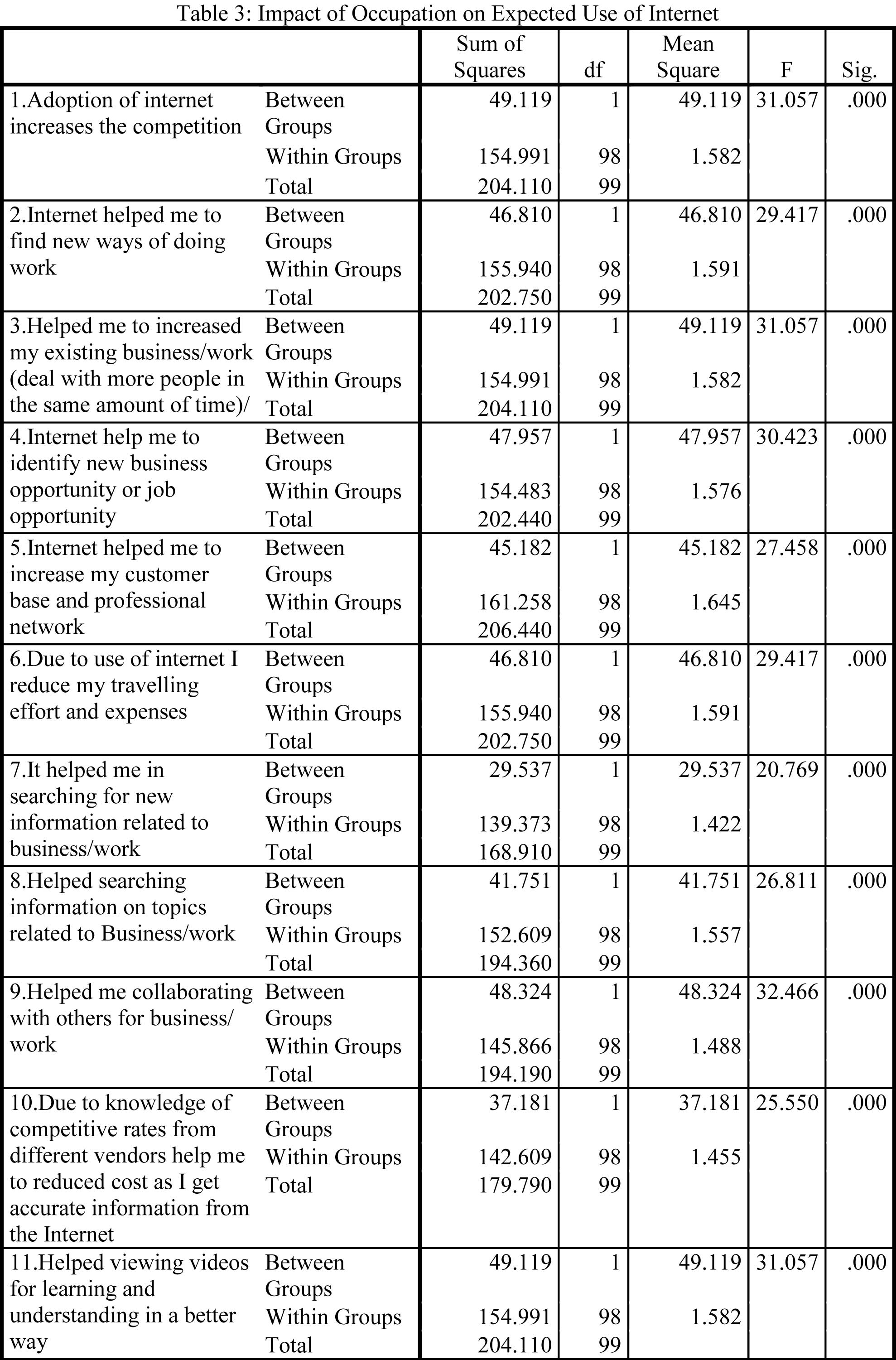
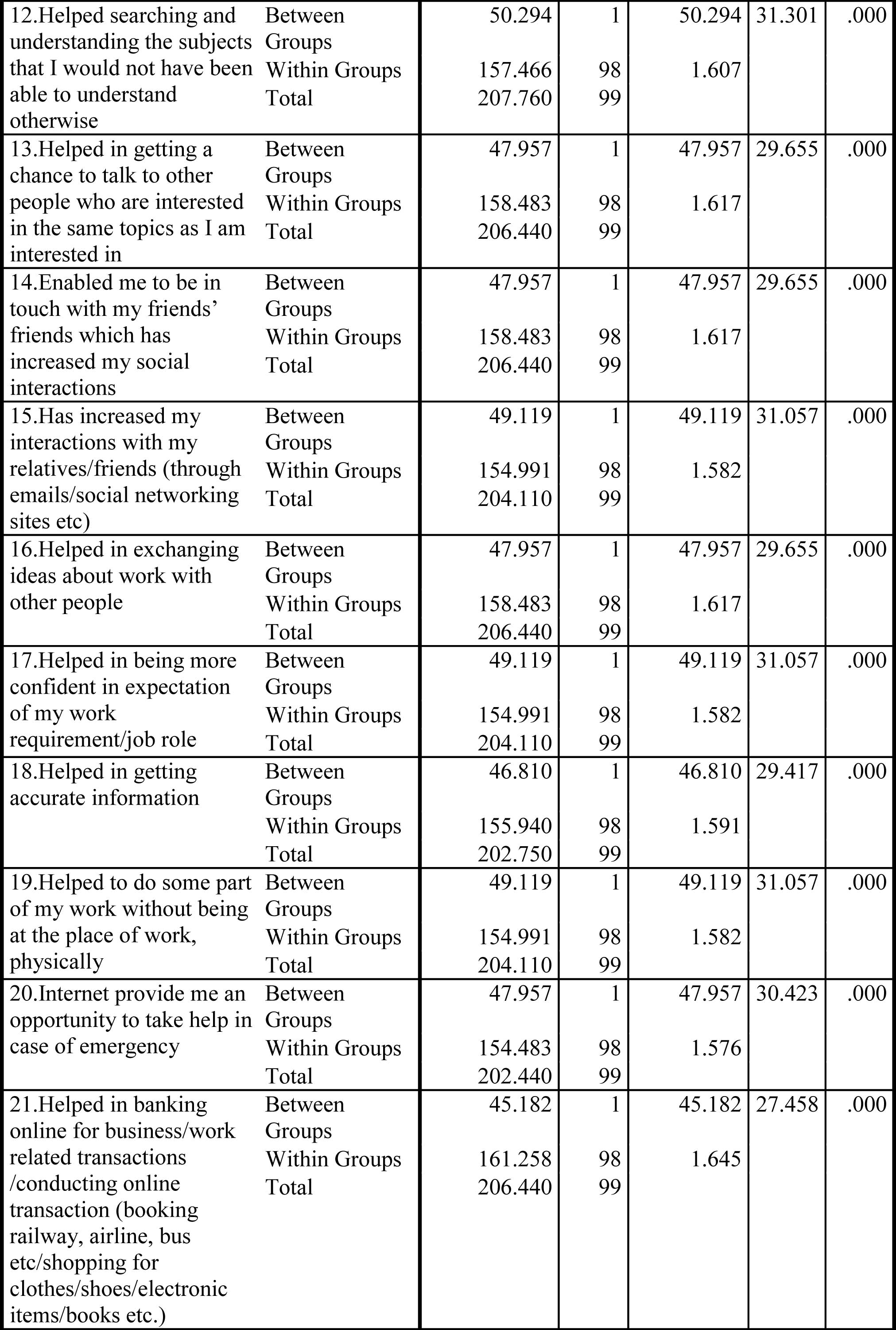
 Impact of income on Expected Use of Internet:
Impact of income on Expected Use of Internet:
Ho3:-There is no significant difference between income and Efficiency of Work, Empowerment, Efficiency in Transaction
Ha3:-There is a significant difference between income and Efficiency of Work, Empowerment, Efficiency in Transaction
One way ANOVA result of occupation in Table 4, on three components Increase in Efficiency of Work, Empowerment, and Efficiency in Transaction at the
5 % level of significance shows that all values are above 0.05. This shows that there are statistically significant differences in responses Hence
the null hypothesis is rejected.
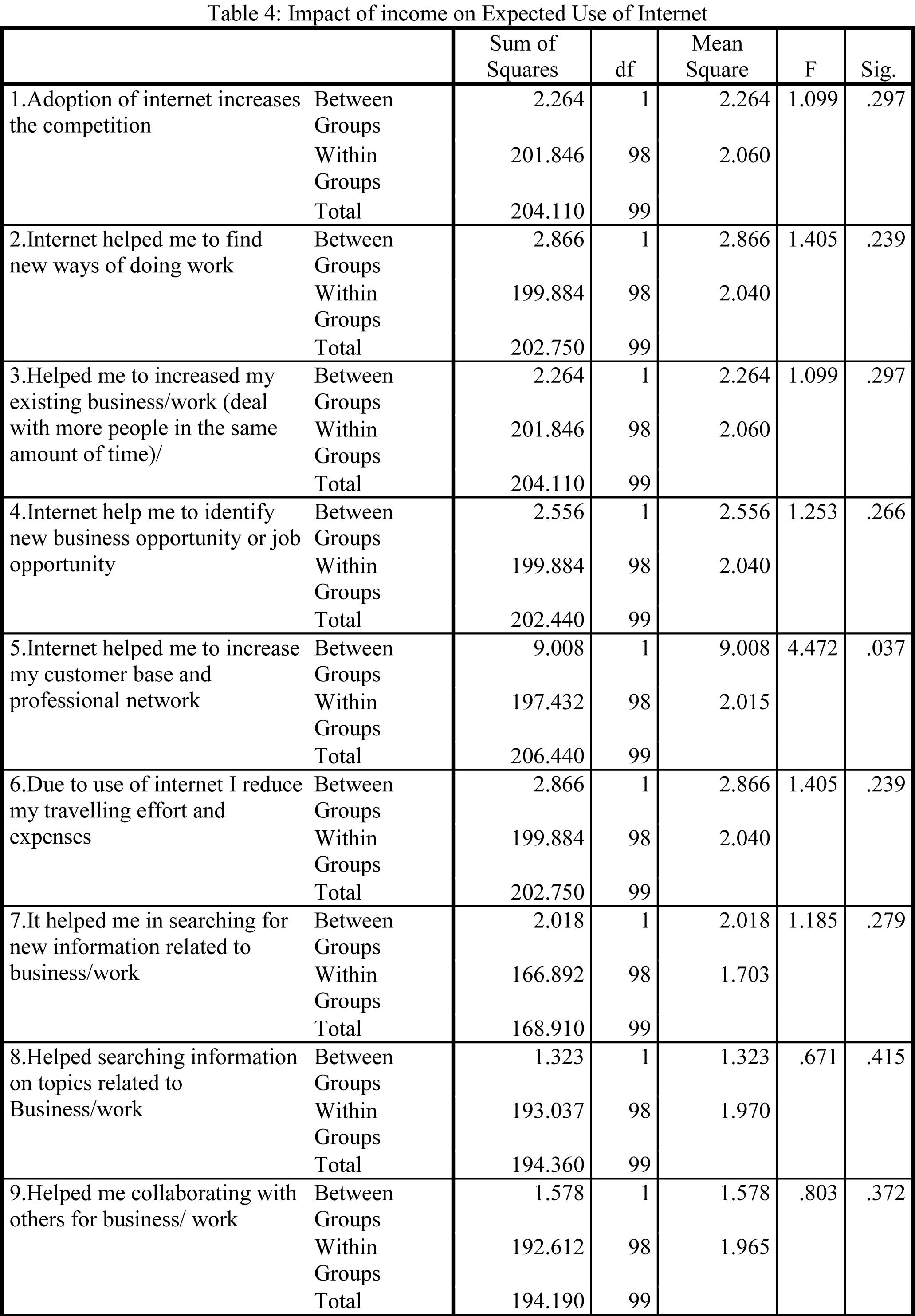
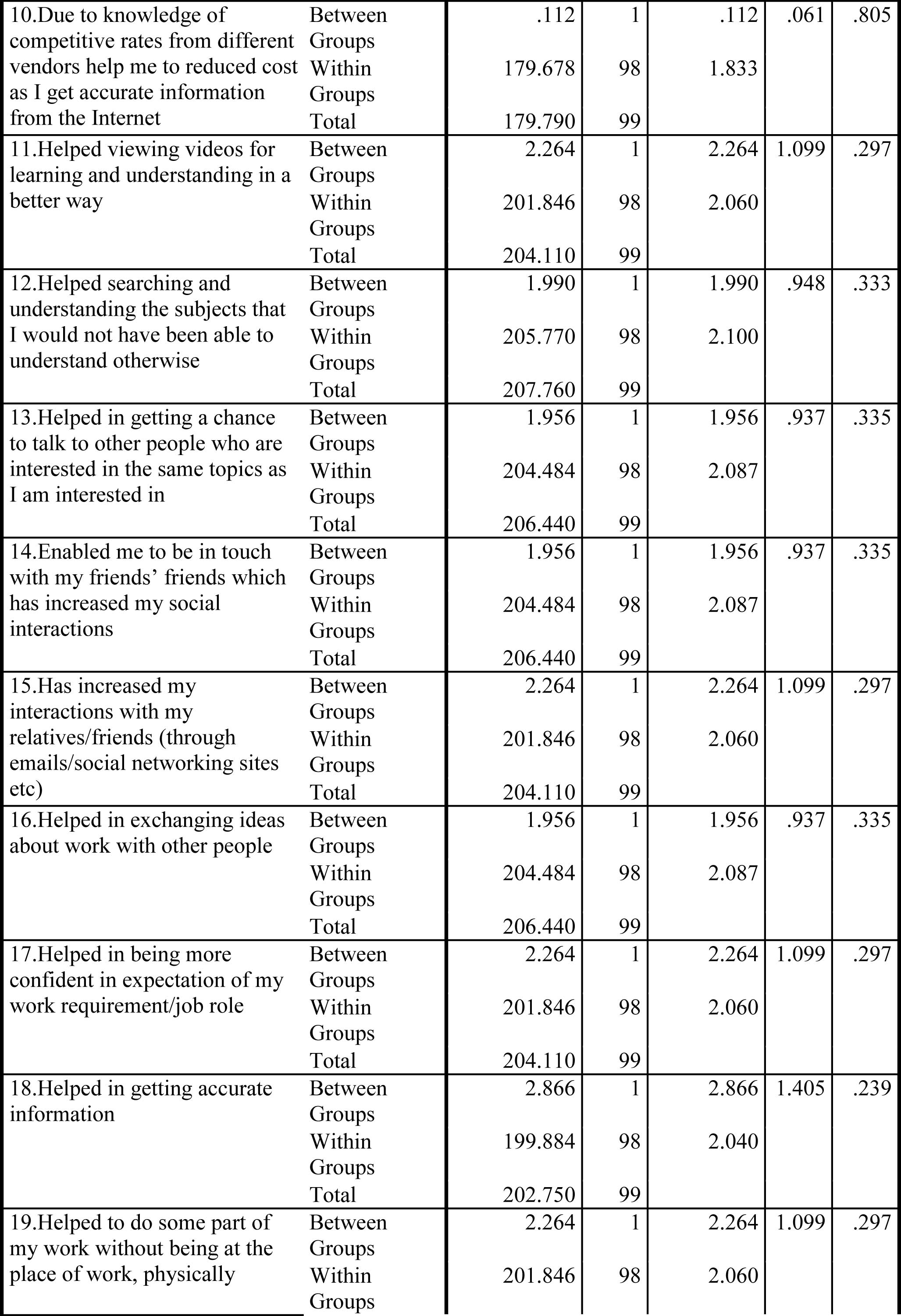
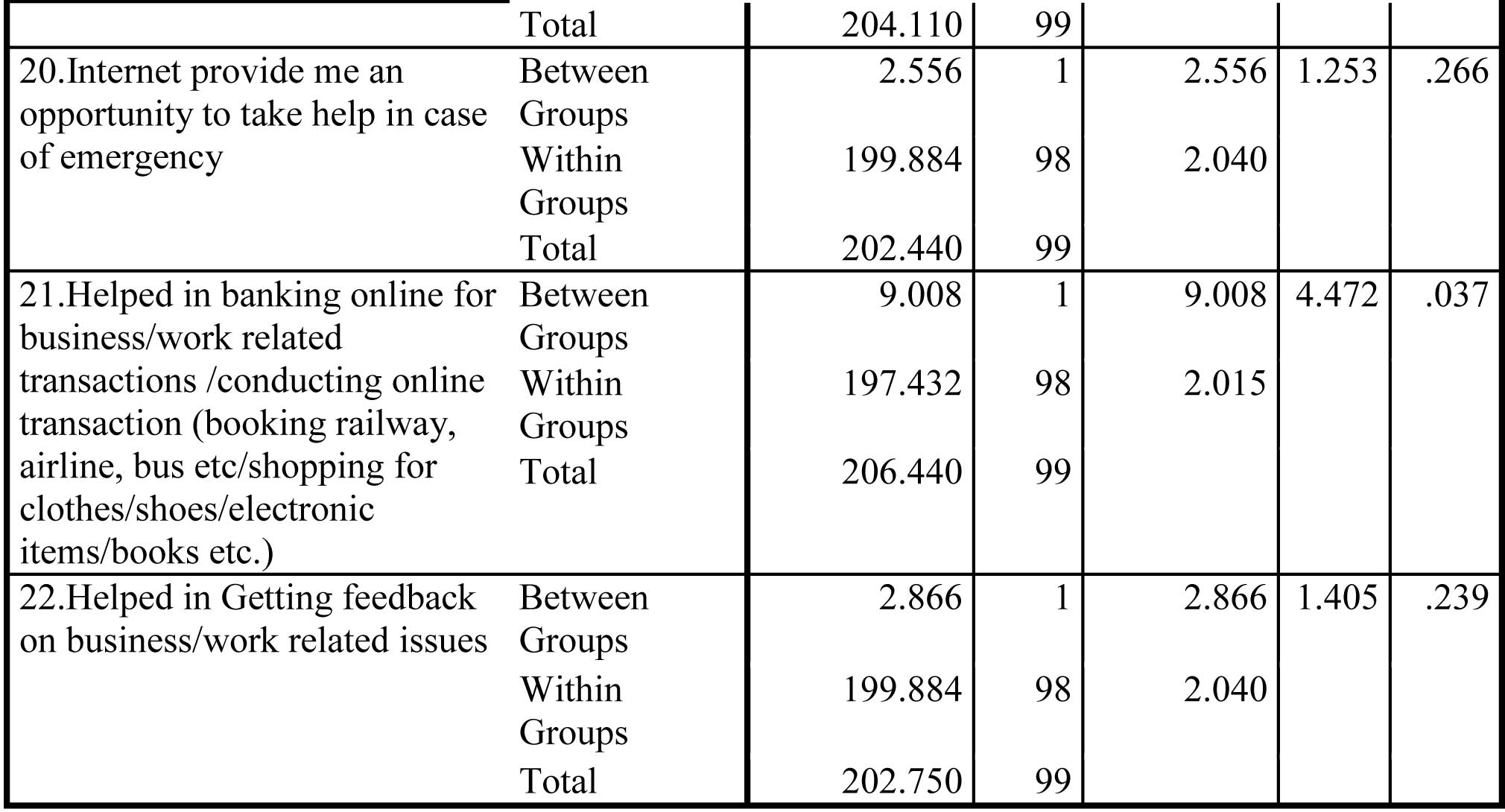 Impact of income on Expected Use of Internet:
Impact of income on Expected Use of Internet:
Ho4:-There is no significant difference between the education and Efficiency of Work, Empowerment, Efficiency in Transaction
Ha4:-There is a significant difference between the education and Efficiency of Work, Empowerment, Efficiency in Transaction
For Education Table 5, on three components Increase in Efficiency of Work, Empowerment, and Efficiency in Transaction at the 5 % level of
significance shows that there are mixed responses. But more number of values are above 0.05 conceded that the null hypothesis is neither rejected
nor accepted.
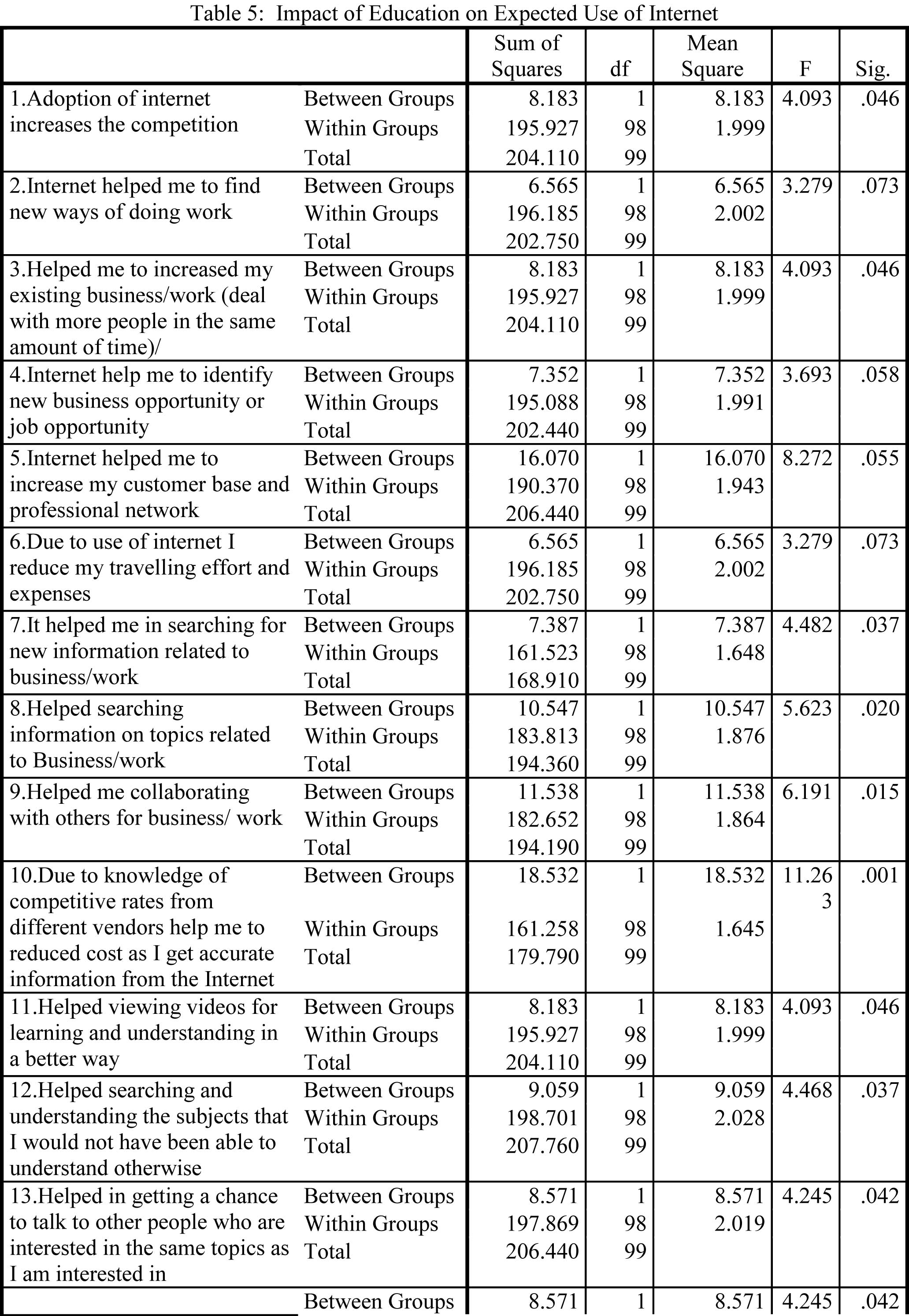
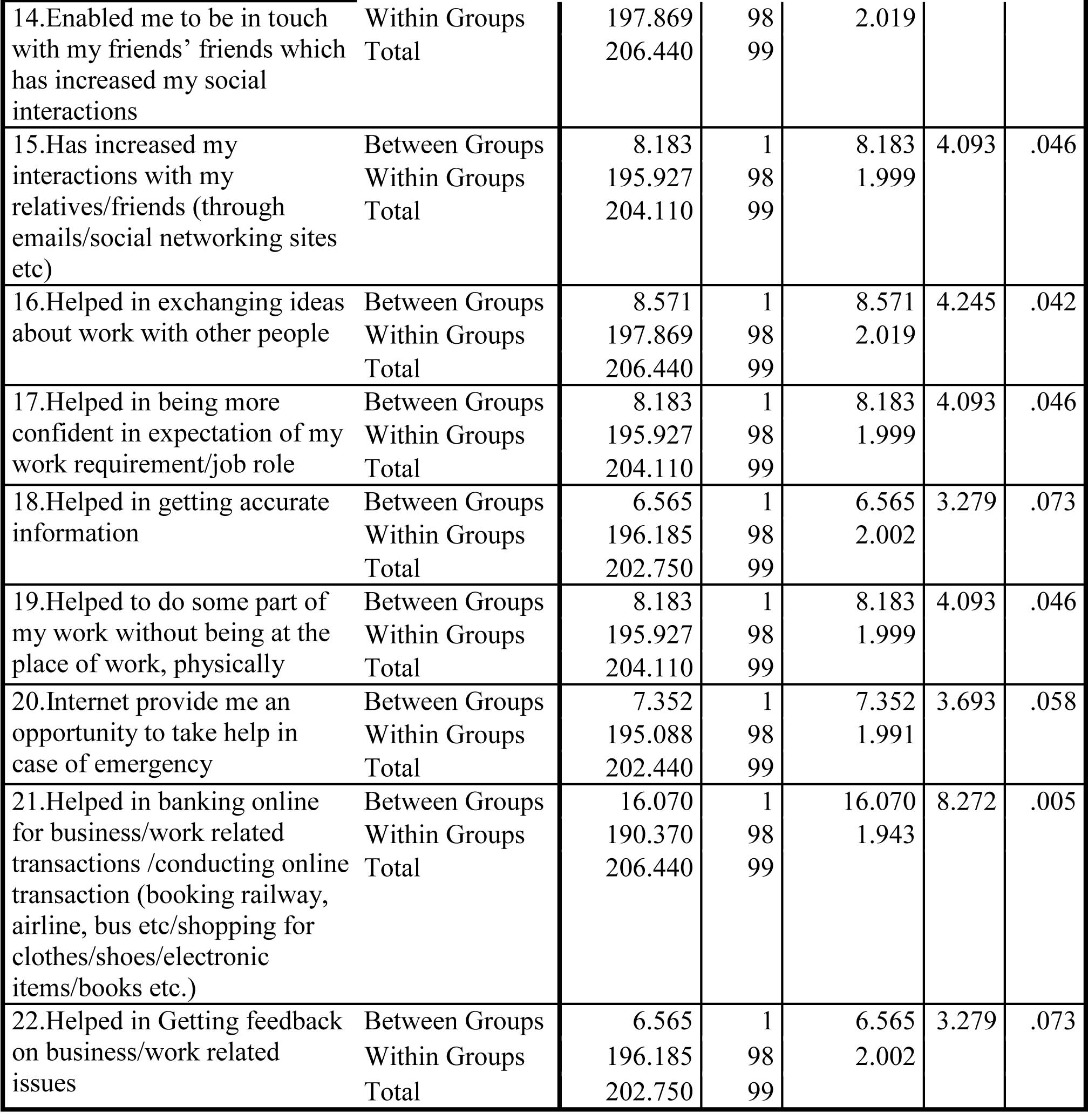 Impact of income on Expected Use of Internet:
Impact of income on Expected Use of Internet:
Ho5:-There is no significant difference between the digital literacy and Efficiency of Work, Empowerment, Efficiency in Transaction
Ha5:-There is significant difference between the digital literacy and Efficiency of Work, Empowerment, Efficiency in Transaction
By using Table 6 for Digital Literacy we reject the null hypothesis. This shows that there is a significant statistical difference in the values at 5
% level of significance.
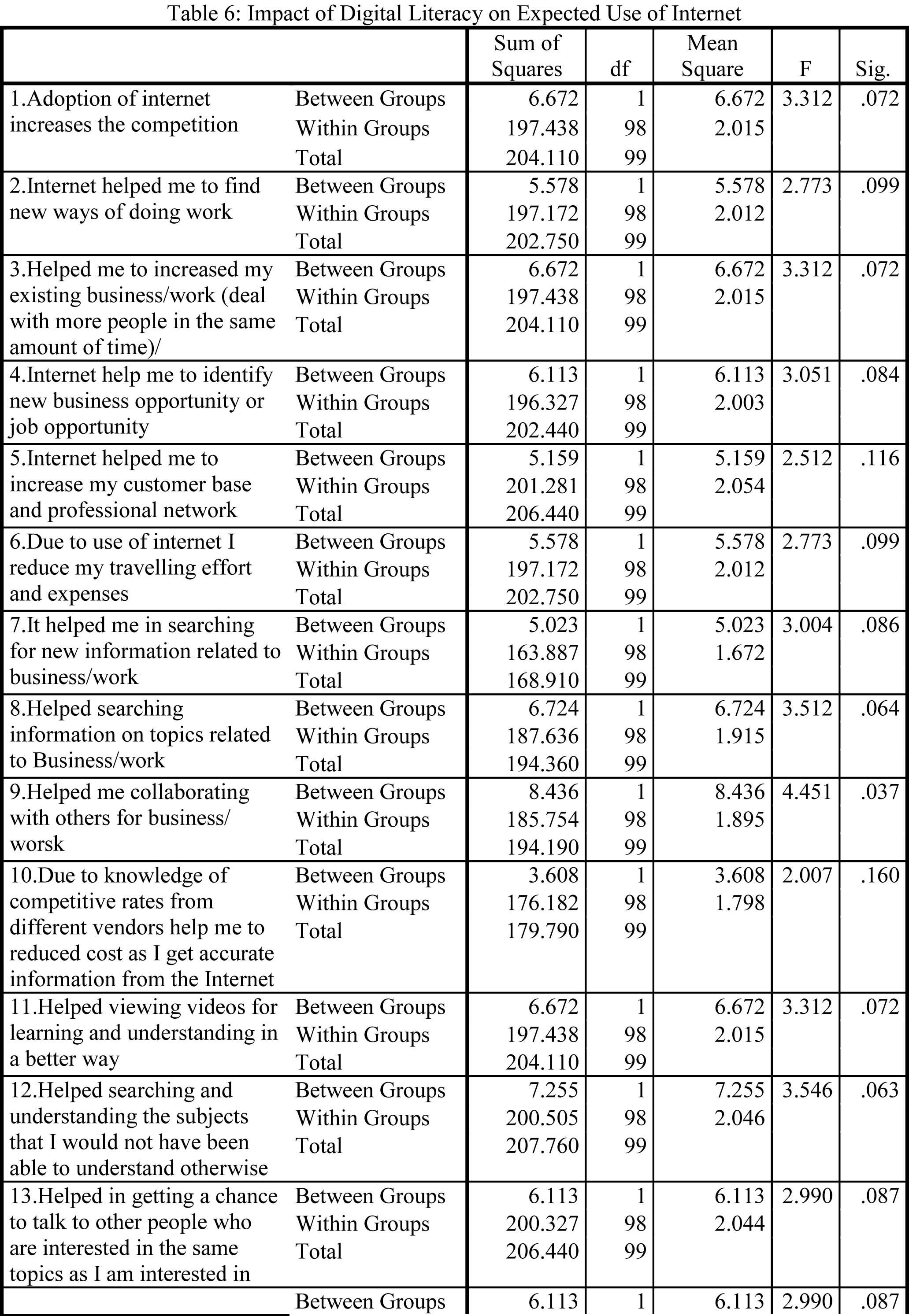
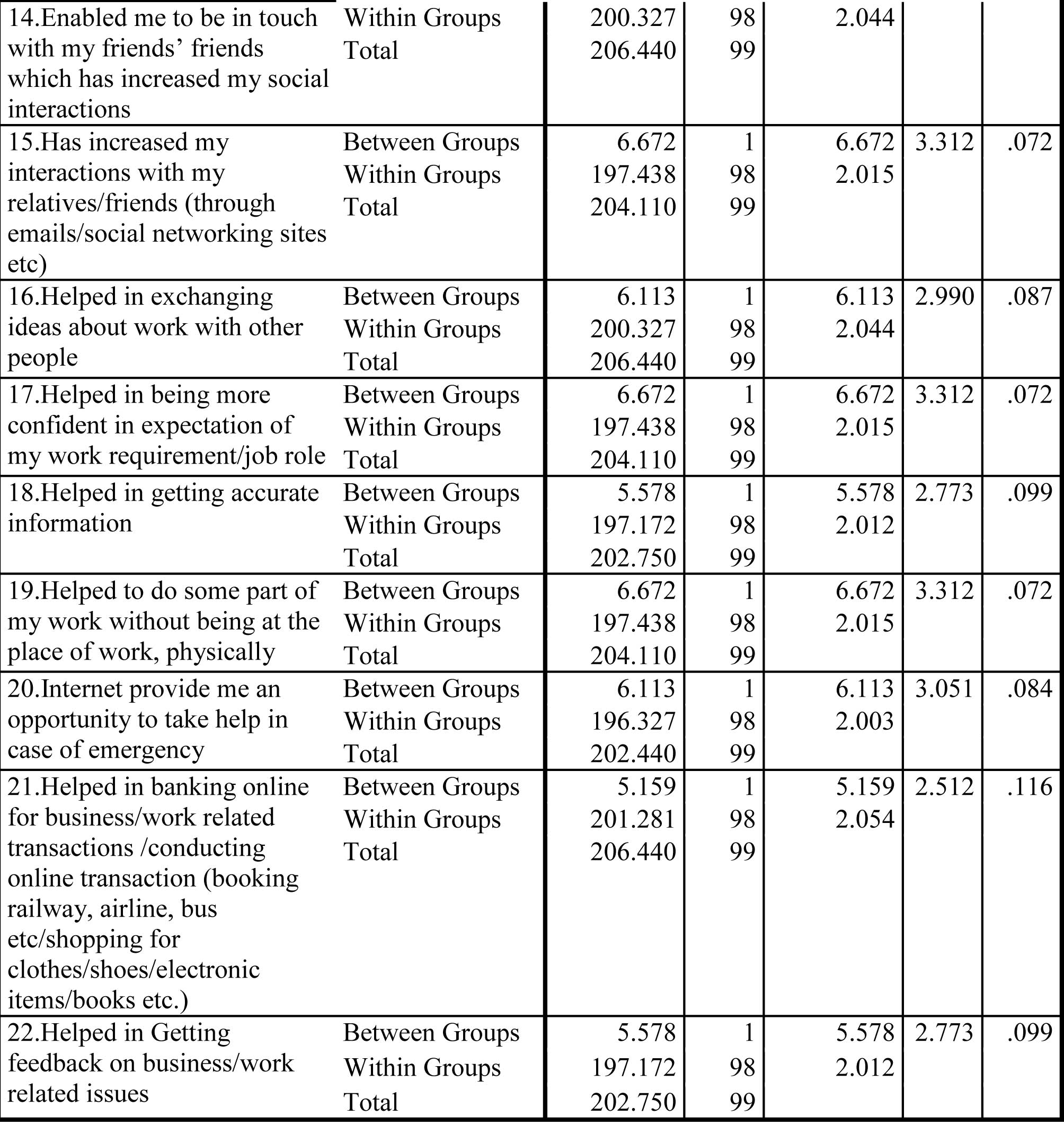
Findings
Age, occupation and education at a certain level is not the deciding factor, but the income, and digital literacy are the major reason for the
effective use i.e for business or knowledge building activities of the internet. The above statistics indicates that possibly the individuals who
used the Internet had high expectation on the enhancement of the scope of work by using the Internet. But actually people in rural areas are not
using it in the proper direction. Effectiveness and efficiency of internet usage in rural area are very less which leads to less awareness,
information and knowledge of the world leads to inefficiency in the market as compared to urban areas.
Major hindrances in the understanding and effective use of internet are found to be educated and digital literacy. The gap between the usage of
internet for entertainment and effective usage could also be due to the individuals not getting enough support for enhancing their scope of the
profession. Individuals in rural areas may be encountered problem in finding enough or relevant content for their profession.lack of content in
local language, Internet connectivity problem may be other reasons for effective usage.
Studies of Internet adoption indicate that users initially begin with the usage of Internet for social purposes. Only when they feel comfortable
with various uses of Internet and see the benefits of online transactions, they may use for it.
On-line transactions, use payment wallet for e-commerce and other services are a relatively newer phenomena and many individuals in rural areas
may not be able to participate due to not having Internet banking, delivery of services to rural area, lack of trust in on-line transactions.
Basic education is playing an important role in understanding the effective and efficient use of the internet which lacks in rural individuals.
Future Scope of Work
Internet adoption generally starts from social media for networking and all and then once the trust is generated and they are looking for the
benefit of the online transaction will go for other usages. For this, it is an early stage of the study.
This study was done in limited rural areas so it could be possible, different areas have a different result from adoption and usage.
The government is also bringing various initiatives and awareness campaigns sometimes force for making the habit of online usage, which
definitely results in increase in effective usage of internet.
Thus, further study after lowering prices of data usage because of disruption in the telecom industry, increase in accessibility by improvement
in services and infrastructure, a government awareness campaign of online usage and improving quality of services may provide greater opportunity
for various online services and promotions of business. Also, this study focused only on Internet users. Further work needs to be done to make it
applicable to a general population.
References :
- Live Mint Fri, Aug 12 2016, “Internet usage picks up in rural India” revealed from http://www.livemint.com/Consumer/QgM23BLpCo4ovHxA0jpOGM/Rural-India-getting-online-faster-BCG-report.html
- Boston consultancy group study by Nimisha Jain and KanikaSanghi , AUGUST 10, 2016 titled, “The rising connected consumer in Rural India” https://www.bcgperspectives.com/content/articles/globalization-customer-insight-rising-connected-consumer-rural-india/#chapter1
- Viswanath Venkatesh1, Tracy Ann Sykes2 andSrinivasan Venkatraman3 May 2014, “Understanding e-Government portal use in rural India: role of demographic and personality characteristics” Issue Information Systems Journal , Volume 24, Issue 3, pp. 249–269
- Prof Rekha Jain, October 1, 2016, “Factors Influencing Perceived Impact of Internet Use on Individuals in Rural India” TPRC44, Research Conference on Communications, Information and Internet Policy,
- DhyanSingh , Online International Interdisciplinary Research Journal, {Bi-Monthly}, ISSN2249-9598, Volume-IV, Nov 2014 ,”A Systematic Review of Literature on effect of Internet Use on Students in India”
- VivekPai , November 18, 2015 in his Report titled, “ 25% of India’s population uses the Internet: IAMAI-IMRB”
- Viswanath Venkatesh1, Tracy Ann Sykes2 and Srinivasan Venkatraman3 ( 2013) conducted a field study in a village in India of e-Government portal use and observed that demographic variables and personality traits
- www.InternetLiveStats.com
Appendix 1: Descriptive Statistics
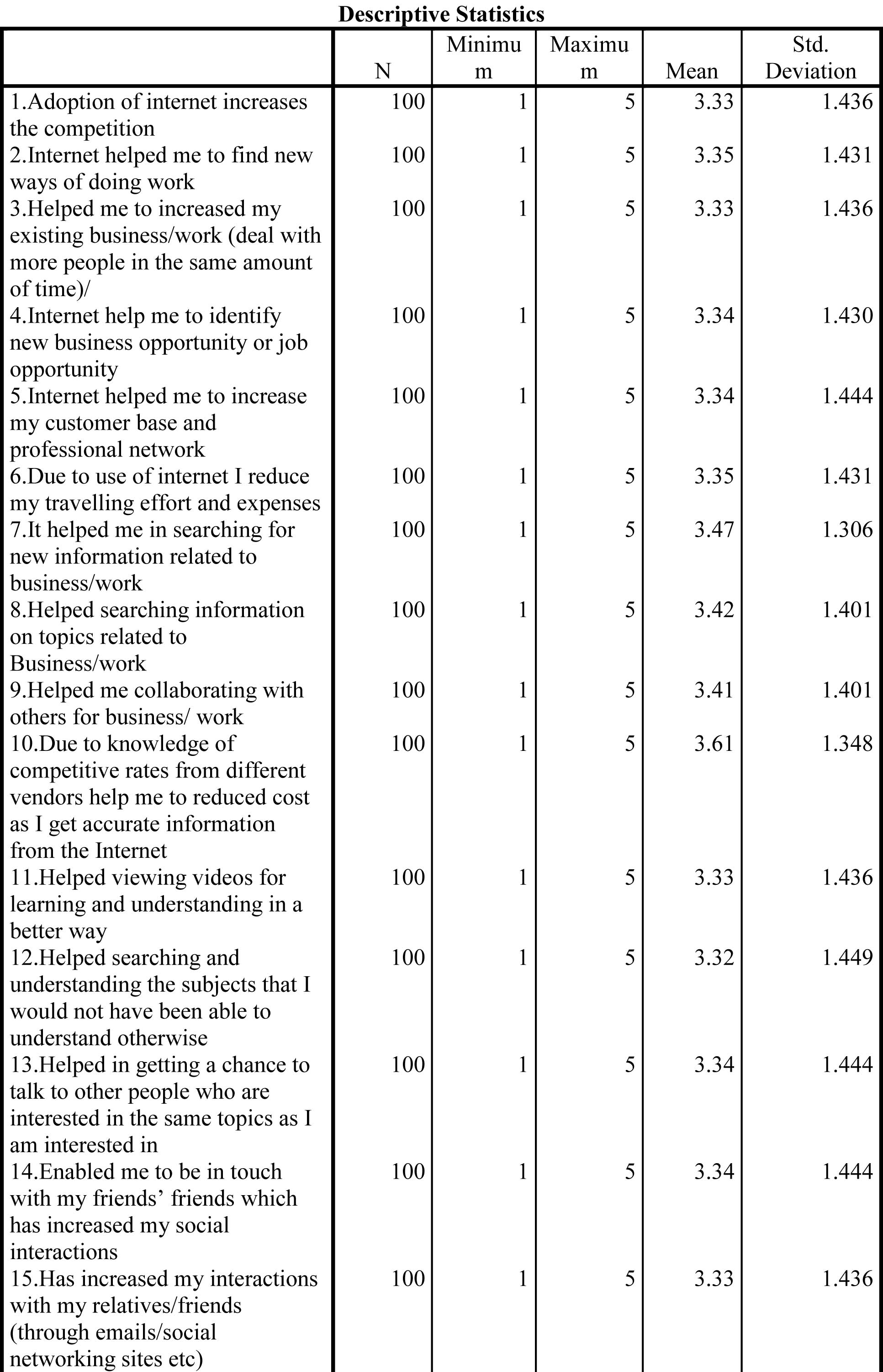
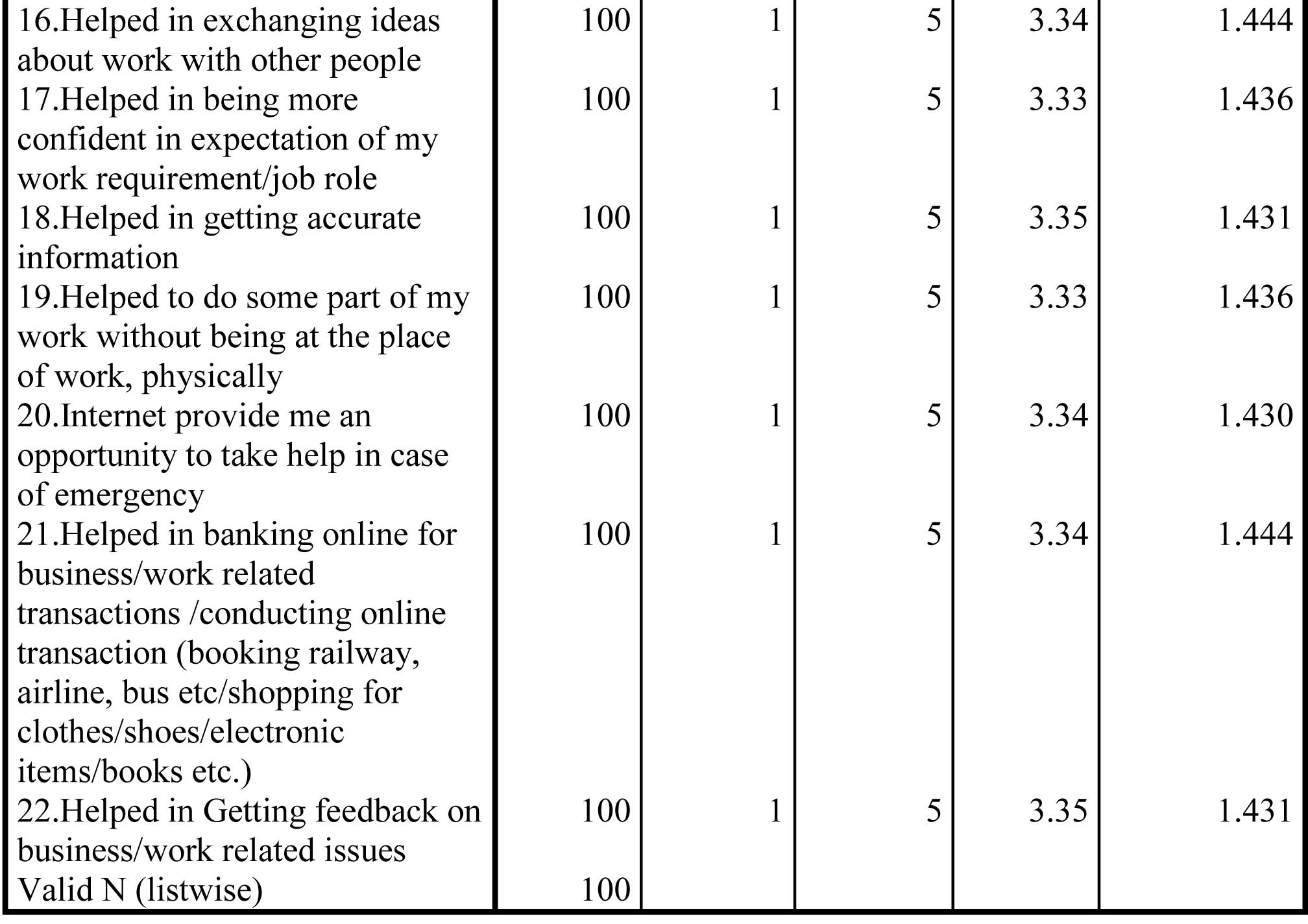
Appendix 1: Descriptive Statistics

